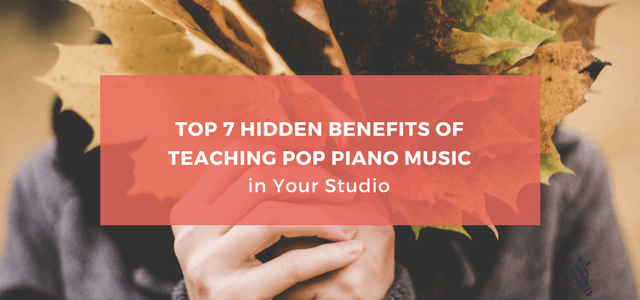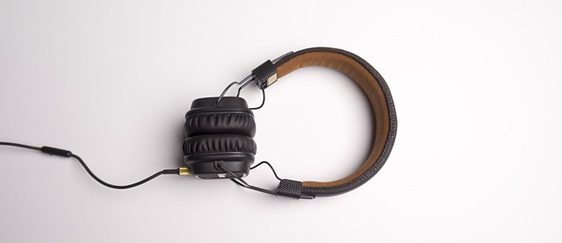
Teaching pop piano music to your piano students isn’t just about appeasing the kids. Pop isn’t simply the cookie that they get for doing their “proper” piano practice.
At least, it shouldn’t be.
Including some songs from the radio in your piano teaching curriculum can do so much more for you and your students than just make them happy.
You just need to dig a little deeper.
Look under the surface of what pop music is and find the hidden gems. Take this tour with me into the less obvious side of teaching pop music and see what it can do for your teaching, students and business.
If you follow blogs like Tim’s, mine, or many others, it might seem like everyone’s teaching pop piano music. Not true. The internet can make things look this way – but the reality is that most teachers still don’t teach much “radio station” music.
Including a wide range of repertoire in your studio will still make you stand out. It will make your teaching a little bit different from others.

Why would you want to be different? Because that gives you a way to market yourself that will stick in people’s minds. Don’t be one in a sea of posters touting “lessons for all ages and levels”.
Say something different.
Be the one teacher in your area who advocates a balanced musical diet. That way, you can become the go-to teacher for students and parents who want that type of studio.
Teen retention is a big issue for piano teachers. This is when students move from a family focused outlook, to a peer centred world. Friends are now at the core of everything they do.
So, if her friends don’t think that piano is cool, chances are your teen won’t be sticking around much longer. At the very least, her practice is going to drop off and her progress will slow.
Like it or not, Bach is not seen as cool by most teenagers. Not yet anyway. But if you teach your student some pop riffs or intros, she might stay in your studio long enough to get hooked on Bach too.
If you’re interested in more on the topic of keeping teens in your studio, you might like to bookmark this post about Treating Your Teens to a Musical Escape to read later.
Don’t worry if your students seem to be shy or nervous of singing, we’re going to bring them round.
Imagine this scenario. Your student brings in the sheet music for a song they want to learn. You say: “Great! Let’s take a look at it together!”
…but then your heart drops.
The right-hand part consists of oscillates between repeated As and Gs for about the first 12 bars or so. This is going to sound terrible. And it’s really not going to be satisfying for your student either. It sounded great with lyrics (at least to your student anyway), but as bare piano notes, it’s going to be repetitive and DULL.
Well. If it sounds good sung – then sing it! Teach your student the piece without the melody line, as an accompaniment not as a solo.
Now, this is where you might have to bring your student round to your way of thinking. She won’t see straight away that this is the better option. She might be shy of singing or claim to not be able to sing.
In all likelihood, she can sing. But you’re going to have to lead by example. Sing along with her so she doesn’t feel shy about it (really belt it if needs be!) and always always always give her positive reinforcement about her singing. Even if she seems to dismiss the praise.
Using this method of teaching pop music, your student will learn so much more than just a cool piece to play for her friends. She’ll learn how to accompany, she’ll train her vocal chords a little, and she might even learn that she is, in fact, a good (or even great) singer. Win, win, win.
If you’re not sure about the whole “singing in the piano studio” thing – take a listen to this podcast I did with Nikki Loney. I go into more detail about why and how I use singing in my piano teaching there.
We all know being a pianist can be a bit…lonely.
Hours spent in the practice room and even on stage by yourself might not be all that appealing to every student. Of course, practice will still have to happen, but if we can add some friends into the mix we’re much more likely to hang on to our students through the teen years.

What, then, does this have to do with pop? Surely students can play duets and trios to get their social musical fix?
They certainly can (and good on you for adding some ensemble work to your studio). But if you teach your student pop, she can play with more of their musician friends. If her friends play guitar, or drums, or sing, then why not teach her a few pop chord progressions so they can play together?
They might even form a band – at the very least they’ll have more opportunities to jam when they’re around their friend’s house.
Did you see Tim’s posts about planning a pop recital? This is a great way to make sure your students get the opportunity to jam with other musicians.
No, learning the latest Adele song isn’t going to get your student a Distinction in their next written exam. But if you’re after functional and practical music theory, pop music is full of opportunities.
Next time your student brings in a song she wants to learn, try some hands-on theory to kick-off the process. Ask your student to:
You get the idea. Look at the next pop piece that a student brings in and start mining for some teaching material. I guarantee you’ll at least find some lovely examples of the I, IV and V chords in there…and maybe even some vi chords for good measure.
When learning pop, it may be better to leave the sheet music out of the equation. Or at least give it a smaller role than it gets in classical music.
That’s because (most of the time) pop music didn’t start on the page. And it often doesn’t make a whole lot of sense by the time it ends up on the staff. The rhythms can be way over a student’s head, and the melody (as we’ve already discussed) is quite often just the same note over and over.
It wasn’t designed for the piano, and it definitely wasn’t designed to help kids learn to play the piano. That doesn’t mean we can’t use it to teach – it just means that sometimes the staff is not the best place to go with it.

Which is why teaching pop music is a great opportunity to get some incognito ear-training into your lessons. Whether you choose to use the score a little, or not at all, encourage your student to use their aural skills to get the piece sounding the way she wants it.
Listen to the song on YouTube together, clap the rhythms, sing it and piece together your own version. This is a much more creative and fun way to learn pop music and your student will develop their musical ear so much in the process.
See Tim’s video How to Teach a Pop Song with No Music for more on this way of working.
Um…isn’t that the same as ear training? Didn’t we just cover that?
Nope. I’m not talking about your students’ ears anymore. I’m talking about your own.
One of the biggest benefits of teaching pop piano music to your students is that they’ll know that you’re listening to them. They’ll feel heard.
When students feel heard, your relationship with them will develop, and they’ll be more likely to defer to your judgement when you really do need to take the steering wheel for a bit.
Let them have a go and choose their type of music, and they might just learn some of your type of music too. They’ll see that you’re on their side and they might just meet you halfway.
Make them feel validated. Show them you’re listening.
Have you got new students because you teach pop? Are any of your students in bands?
I’d love to hear your thoughts on the role of pop piano music in your teaching studio (whether it’s big or small) in the comments below.

Peta says:
Hi Tim
I am a member of inner circle and have got a lot out of a recent webinar/workshop on teaching pop.
I helped one of my students play a simple version of City of Stars from La La Land. We just used the first sheet of music to get the melodic line and chords and in 20 mins he was playing the first 9 bars without looking much at the music!
Nicola says:
Hi Peta! Well done on teaching City of Stars this way – that one has come up in my studio and I’ve used “Tim tricks” to teach it as well. 🙂